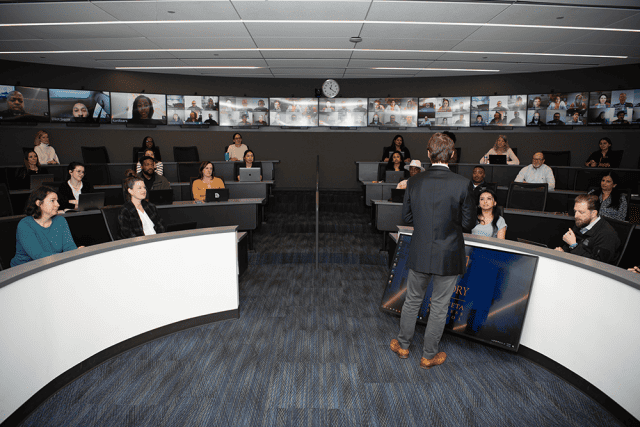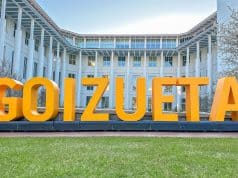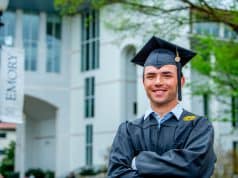With the help of The Roberto C. Goizueta Global Classrooms, the bright faces of Emory’s Goizueta Business School students are lighting up the building.
Signing in from couches and coffee shops across the country, business school students are increasingly taking advantage of Goizueta’s expanding online presence. The investments made in digital learning have helped broadcast the school’s faculty and rigorous curriculum into remote corners of the globe, garnering a diverse student base and spreading the Goizueta brand near and far.
More Options and Increasing Demand
Today’s students are increasingly selective in when and how they learn. While there will always be those who prefer in-classroom learning, embracing hybrid and fully remote models is critical to staying relevant.
“We’re in an era where flexibility is a requirement of our students,” says Associate Dean of Executive MBA & Evening MBA Programs Jackie Conner. “If you can’t offer flexibility, you can’t compete anymore. This technology affords a great deal of flexibility for our students; they aren’t restricted to one modality of learning.”
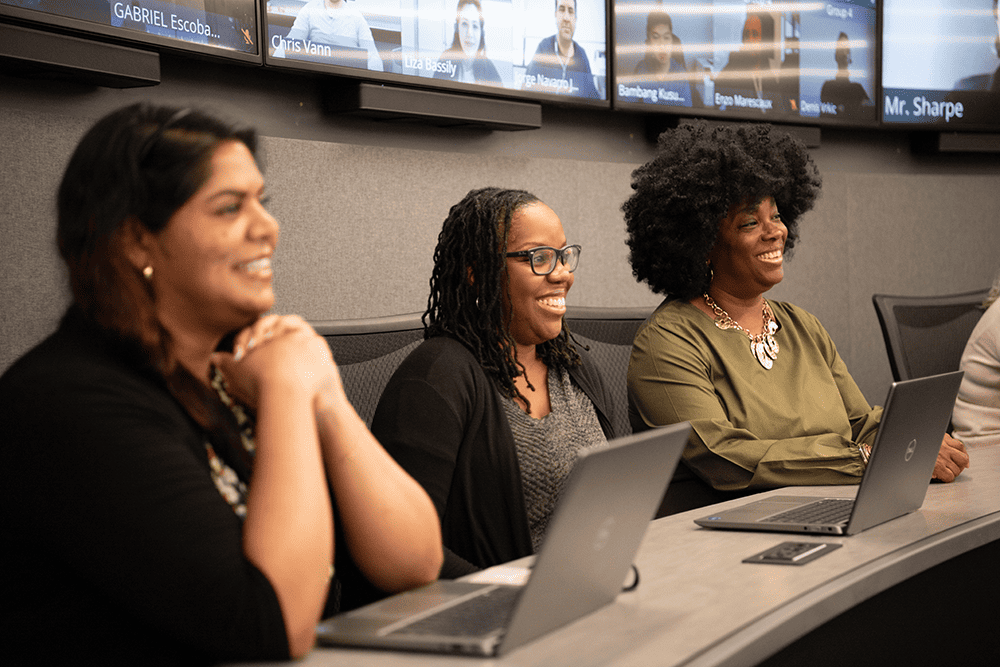
With this evolving landscape in mind, the school has elected to capitalize on the success of the initial Global Classrooms set-up. The Global Classroom suite has now doubled from three to six rooms. Two of these rooms are hybrid rooms, designed to synchronously accommodate in-person and remote students. In addition, the business school has plans on the horizon to provide online options for more degree programs and their affiliated coursework. The Executive MBA and Evening MBA programs now offer all of their core classes both online and on campus, giving students the best of both worlds.
A Boon for the Evening MBA and Executive MBA Programs
While the Global Classrooms prove critical in many Goizueta-affiliated events and seminars, the success of the Evening MBA program and the Executive MBA program have helped drive this growth in particular.
These two programs benefit from the sophisticated technology of the classrooms because of the student base they attract. Though in different career stages, both Evening MBA and Executive MBA students are likely to be older than the average MBA student, and many are already working professionals with families and roots established outside Atlanta.
“This type of technology allows our enrollment to grow,” says Conner. “We’re no longer constricted by physical space. Still, we’re committed to our core values.
Goizueta is known and highly valued for its intimate atmosphere—it’s one of the aspects of our program that makes us unique. Maintaining the balance of student-to-faculty ratios and keeping our focus on highly engaging learning experiences remains top priority.”
Jackie Conner
An Immersive Experience
How do we diversify our student base to include those who would otherwise not have access to Emory’s campus?
Former dean Erika James asked this question several years ago. Such students— older students, students with families, students transitioning from other careers, students who live in rural areas, and international students—are often left behind in broader discussions of student diversity.
Wanting to keep ahead of the curve, James helped secure a $30 million dollar grant from The Goizueta Foundation in 2019—the largest in the school’s history. Roughly a third of the grant was allocated specifically for the Global Classroom initiative and education innovation, including holopresence technology, virtual reality simulations and improving the immersion experience of online learning.
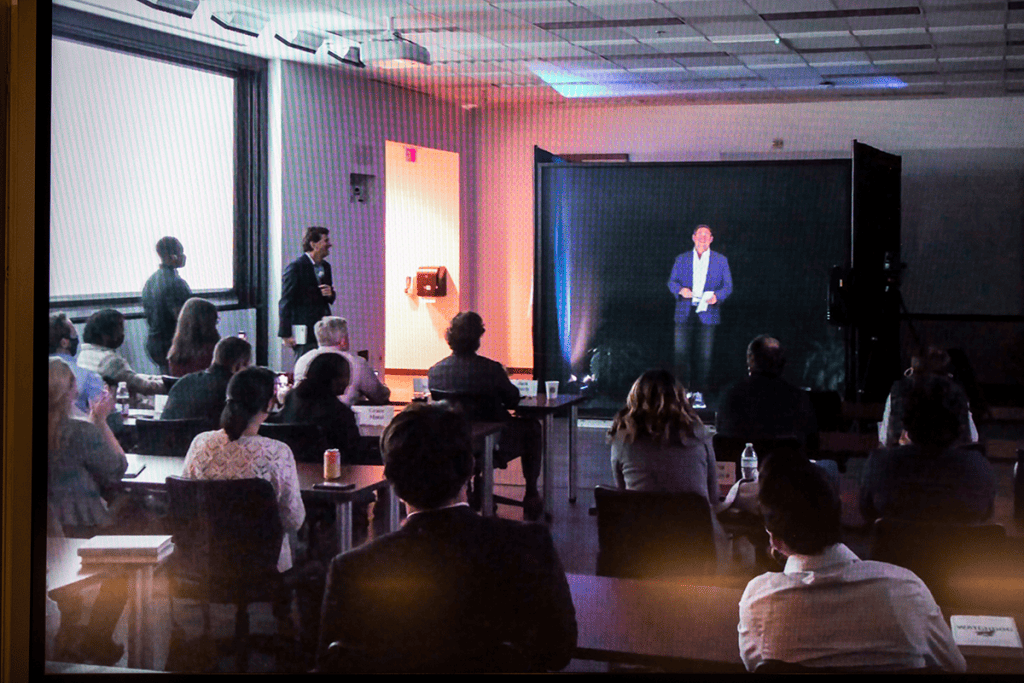
Jackie Conner stepped in to carry the torch shortly thereafter.
“This online format provides broader outreach and more diverse perspectives of thought for the whole class,” says Conner. “Enrolling students from all over the world is extremely valuable to our faculty, to our alumni base, and to the overall Goizueta community. We strongly value their perceptions, opinions, and perspectives, especially at a global level.”
Conner also emphasizes that while they’re breaking down geographical barriers, with students joining from Idaho to Texas to California and abroad, they’re also including people right next door who would otherwise not have flexibility to commute to campus.
Stepping into a Global Classroom feels like stepping into the future. The classrooms rely on many technological features to achieve that immersive atmosphere. There are ceiling mics everywhere. The “perspective view” feature, which includes special cameras and directional speakers, allows professors to have one-on-one interactions with students that feel like real life. The largest fully virtual room has 27 screens; each screen can host between one and six students, and each screen has a devoted camera and sound system. Unlike seminars held over Zoom and other software, everyone can be visible at once.
“We’re really focused on the experience of the classroom, because we know learning outcomes are heavily influenced by these factors,” says Conner. “When it comes to retaining knowledge, the delivery matters.”
Naturally, trailblazing in educational technology has come with a learning curve. Faculty and teaching assistants are offered extensive training on the many features available to them through the global classrooms. Yet they need never fear; a production assistant is on call at all times to handle technical matters. Gone are the days of faculty forced to fumble with equipment while trying to maintain focus on their course content.
Senior Media Manager Kevin Sharpe heads this specialized squad with three other team members—and they’re busy.
“We’re using at least three to four rooms every night of the week,” says Sharpe.
Improving Accessibility and Participation for Different Kinds of Learners
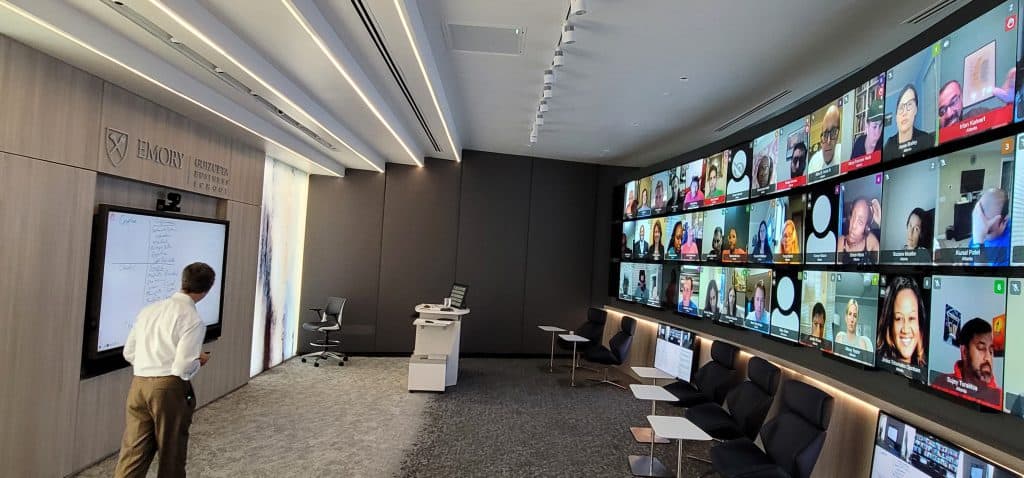
Some research demonstrates that online learning can also allow different kinds of learners to shine compared to in-person environments, such as introverted learners. Peer-to-peer learning also thrives in the online classroom, an educational tenant with increasing support from researchers. In addition, the closed caption feature can be an enormous benefit to English as a Foreign Language students and students with hearing impairments.
The hand raise feature also allows the professor to see a list of who has raised their hands and in what order, technology that assists the professor in ensuring they’re engaging with students equally. Professors can also take advantage of breakout group functions and, unlike Zoom, they can see the small groups and join their conversations—just like an in-person classroom.
One of the most powerful features of the global classrooms are the learning analytics functions. Faculty can conduct real-time open ended or multiple choice polls to assess learning in real time. At the end of class, faculty can also download class participation data to assess the engagement level of each student.
The software also uses AI to assess student questions.
“The ability to use a digital platform to capture that data to provide to the instructor in real time is revolutionary,” says Conner. “As you are teaching, managing a chat board is almost impossible. But having a system that is looking for commonalities and provides a report showing keywords mentioned a number of times by a significant number of students—that is a game-changer!”
“The way the technology works, it’s harder for any student to fall through the cracks,” says Sharpe.
Conner is thrilled with the progress the school has made thus far, and looks forward to seeing Goizueta’s reach continue to expand.
“It’s history in the making.”
How can an Executive MBA enhance your future? Learn more today.
Learn more about Goizueta’s top-ranked Evening MBA program—a full-time program in a part-time schedule.


